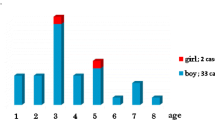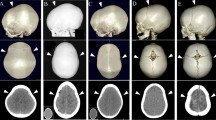Abstract
Background and purpose
Sagittal craniosynostosis (SCS) is common and easily recognized and corrected surgically. However, rare cases of SCS are more complex: these associate closure of the metopic or delayed closure of the coronal suture, uni- or bilaterally.
Material and methods
We reviewed the available literature on atypical sagittal craniosynostosis (ASCS). We also reviewed retrospectively our series of SCS treated since 1980 and selected cases with simultaneous closure of the metopic (leptocephaly) or delayed closure of other sutures (plagiocephaly, oxycephaly, or Crouzon syndrome).
Results
ASCS is rare, representing <10 % of SCS. In our series, among 447 cases of SCS followed for a mean duration of 63.7 months, we identified 22 cases of ASCS: 6 with leptocephaly, 9 with non-syndromic oxycephaly, 4 with Crouzon syndrome, and 3 with plagiocephaly. Fourteen patients required a second operation, either planned initially (severe leptocephaly) or because of brain compression. The actuarial incidence of ASCS requiring reoperation was 5.3 % of SCS at 10 years. After a mean follow-up of 113 months, morphological results in ASCS were grade 1 (no defect) in 5, grade 2 (mild defect) in 2, grade 3 (minor reoperation) in 3, and grade 4 (major reoperation) in 12; one patient had visual impairment, and two had learning difficulties.
Conclusions
ACSC can be detected initially or occur with a delay in apparently standard SCS. Leptocephaly is a specific entity. Because of the implications on the management and risk for the patient, preoperative evaluation of patients with SCS with CT scanner and prolonged follow-up are necessary.






Similar content being viewed by others
References
Agrawal D, Steinbok P, Cochrane DD (2005) Diagnosis of isolated sagittal synostosis: are radiographic studies necessary? Childs Nerv Syst 22:375–378
Agrawal D, Steinbok P, Cochrane DD (2006) Reformation of the sagittal suture following surgery for isolated sagittal craniosynostosis. J Neurosurg 105(2 Suppl):115–117
Arnaud E, Capon-Degardin N, Michienzi J, Di Rocco F, Renier D (2009) Scaphocephaly part II: secondary coronal synostosis after scaphocephalic surgical correction. J Craniofac Surg 20(Suppl 2):1843–1850
Averbeck D (2009) Does scientific evidence support a change from the LNT model for low-dose radiation risk extrapolation? Health Phys 97:493–504
Berrington de González A, Darby S (2004) Risk of cancer from diagnostic X-rays: estimates for the UK and 14 other countries. Lancet 363:345–351
Captier G, Bigorre M, Rakotoarimanana JL, Leboucq N, Montoya P (2005) Étude des variations morphologiques des scaphocéphalies. Implication pour leur systématisation (Study of the morphologic variations of the scaphocephaly. Deduction for their systematisation). Ann Chir Plast Esthet 50:715–722
Connolly JP, Gruss J, Seto ML, Whelan MF, Ellenbogen R, Weiss A, Buchman SR, Cunningham ML (2004) Progressive postnatal craniosynostosis and increased intracranial pressure. Plast Reconstr Surg 113:1313–1323
Dhellemmes P, Lejeune JP, Hladky JP, Gonzales R, Pellerin P (1994) Linear coagulation of the dura in the treatment of craniosynostosis. Childs Nerv Syst 10:410, abstract
Domeshek LF, Das RR, Van Aalst JA, Mukundan S Jr, Marcus JR (2011) Influence of metopic suture fusion associated with sagittal synostosis. J Craniofac Surg 22:77–83
Goodrich JT (2004) Craniofacial reconstruction for craniosynostosis. In: Goodrich JT, Staffenberg DA (eds) Plastic techniques in neurosurgery, 2nd edn. Thieme, New York, pp 56–93
Greene CS (1998) Pancraniosynostosis after surgery for single sutural craniosynostosis. Pediatr Neurosurg 29:127–132
Haas LL (1952) Roentgenological skull measurements and their diagnostic applications. Am J Roentgenol Radium Ther Nucl Med 67:197–209
Heller JB, Heller MM, Knoll B, Gabbay JS, Duncan C, Persing JA (2008) Intracranial volume and cephalic index outcomes for total calvarial reconstruction among nonsyndromic sagittal synostosis patients. Plast Reconstr Surg 121:187–195
Jane JA, Persing JA (2000) Neurosurgical treatment of craniosynostosis. In: Cohen MM, MacLean Ruth E (eds) Craniosynostosis: diagnosis, evaluation, and management. Oxford University Press, New York, pp 209–227
Nelhaus G (1968) Head circumference from birth to eighteen years. Practical composite international and interracial graphs. Pediatrics 41:106–114
Reddy K, Hoffman H, Armstrong D (1990) Delayed and progressive multiple suture craniosynostosis. Neurosurgery 26:442–448
Renier D, El Ghouzi V, Bonaventure J, Le Merrer M, Lajeunie E (2000) Fibroblast growth factor receptor 3 mutation in nonsyndromic coronal synostosis: clinical spectrum, prevalence, and surgical outcome. J Neurosurg 92:631–636
Seto ML, Hing AV, Chang J, Hu M, Kapp-Simon KA, Patel PK, Burton BK, Kane AA, Smyth MD, Hopper R, Ellenbogen RG, Stevenson K, Speltz ML, Cunningham ML (2007) Isolated sagittal and coronal craniosynostosis associated with TWIST box mutations. Am J Med Genet A 143:678–686
Shin JH, Persing JA (2002) Sagittal synostosis. In: Lin KY, Ogle RC, Jane JA (eds) Craniofacial surgery: science and surgical technique. Saunders, Philadelphia, pp 225–232
Terner JS, Travieso R, Lee SS, Forte AJ, Patel A, Persing JA (2011) Combined metopic and sagittal craniosynostosis: is it worse than sagittal synostosis alone? Neurosurg Focus 31(2):E2. doi:10.3171/2011.6.FOCUS11100
Vu HL, Panchal J, Parker EE, Levine NS, Francel P (2001) The timing of physiologic closure of the metopic suture: a review of 159 patients using reconstructed 3D CT scans of the craniofacial region. J Craniofac Surg 12:527–532
Whitaker LA, Bartlett SP, Schut L, Bruce D (1987) Craniosynostosis: an analysis of the timing, treatment, and complications in 164 consecutive patients. Plast Reconstr Surg 80:195–212
Author information
Authors and Affiliations
Corresponding author
Rights and permissions
About this article
Cite this article
Vinchon, M., Pellerin, P., Guerreschi, P. et al. Atypical scaphocephaly: a review. Childs Nerv Syst 28, 1319–1325 (2012). https://doi.org/10.1007/s00381-012-1807-8
Received:
Accepted:
Published:
Issue Date:
DOI: https://doi.org/10.1007/s00381-012-1807-8




